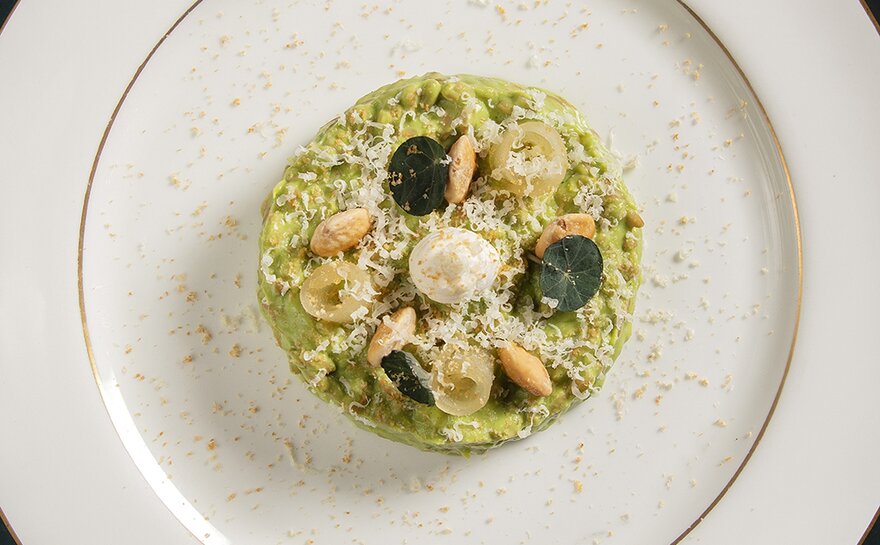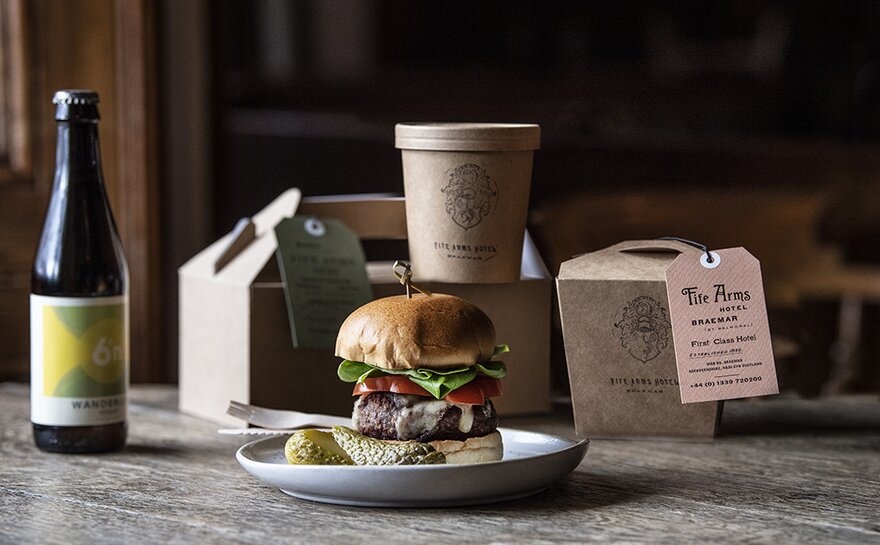Adam Maddock has embraced all Scotland has to offer as head chef at the Fife Arms, creating contemporary cooking with a wild edge
Tell us a little bit about your journey to the Fife Arms
I did my apprenticeship with Chris and James Tanner, and I then spent two years at Gidleigh Park in Newton Abbot in Devon with Michael Caines as a demi chef de partie. I then headed to Whatley Manor in Malmesbury in the Cotswolds under Martin Burge between 2011 and 2015, where I experienced every aspect of the kitchen.
I hopped over to Manor House in Chippenham in Wiltshire as junior sous and spent a year there, then when Niall Keating joined Whatley Manor in 2016 I bounded back over there to work with him for a year. After that I went to the Driftwood hotel in Truro in Cornwall as senior sous chef, where we managed to take it from three AA rosettes to four.
I had a bit of a break from kitchens during Covid and then got my first head chef position at the Elms Hotel & Spa in Abberley in Worcester in 2021, where I oversaw the two dining rooms for a year. I like being busy, and since my time at Whatley Manor I have liked the set-up of multiple restaurants out of one kitchen, which is how it is at the Fife Arms, which I joined in March.
You're a long way from your birthplace in Devon in the south-west of England – are you enjoying Scotland?
Bringing up children in the Scottish landscape really appealed to me and my partner – city life isn't for me. Here it's all rolling hills and, as a chef, you feel more connected to the produce that comes through the door, because you'll see the lamb in the fields that you'll be using in a few months' time, or you'll have a stag run across the road in front of you.
What is the best lesson you've taken from the kitchens you've worked in over the years?
I took the most influence from my time with Martin Burge – while he used classical French cooking techniques, he was all about cleanness of flavour and not overdoing it with the butter. We didn't use any emulsions and we made sure the veg tasted of veg.
So what's your cooking style today?
It's not fussy. Instead of bombarding a plate with 16 different flavours, I stick to six maximum to make sure the produce doesn't get lost. I want the produce to do the talking and, I know that is a clichéd thing to say, but you don't want to hide the taste of the scallop, the mackerel or the beef.
What's the style of the food at the Fife Arms?
We have a relaxed fine dining restaurant, the Clunie Dining Room, which is open for dinner Tuesday to Saturday and serves 40-50 covers a day. Here, 90% of the menu is cooked over fire in front of the guest with the pass on show at the end of the restaurant.
We also have the Flying Stag, which is an all-day restaurant open seven days a week, which serves around 200 covers a day. It's a pub for the locals with one section where you can sit down with a scotch egg or a sausage roll and another offering classic dishes.
As head chef, I also look after breakfast, afternoon tea, events and bespoke menus. Our guests will stay on average for two nights so they can dine at each restaurant, but we also offer a lot of food-led experiences, such as going fishing for the day. When guests come back with their catch we prep it and cook it however they want it.
Rachael Henley was appointed general manager of the Fife Arms shortly before you joined. How do the two of you work together?
We touch base every day and have a good working relationship. Rachael has a background in F&B so that really helps – on Christmas Day I was on one pass and she was on the other.
We have the local Braemar Games coming up in September, so there's a lot going on with the logistics side of that. But we're both hands-on and we do what we need to do to make sure the guests get what they need, despite the kitchen being a reasonably small team. We should number around 30, including kitchen porters, but there's around 12 of us at the moment. For instance, on Saturday, we had the Clunie and the Flying Stag open, and we had 50 people enjoying a five-course tasting menu for a wedding – we just delegate and make sure we're as ready as possible and eliminate any hiccups. The event team spends months planning it down to the final minute – but the guests would never realise that.
Where do you get your inspiration from?
From the landscape and my suppliers. I'll get an email from my suppliers saying something is coming in that is really good, or my local forager will let me know weekly what is available.
We also have the Fish Shop in Ballater, a sister property to the Fife Arms, and if they have something that's really good, they'll pass it onto us. I try not to change the Clunie menu very often, because my kitchen manager doesn't like me very much if I do that, so we change it when we need to.
I remember I went through a phase in my first head chef job where I'd change the menu every few days, but I was getting to know myself and you need to be confident in what you're serving. It's a learning curve and I think you need to let the team bed in and get to know a dish, otherwise you're changing it as soon as they've got used to it and you start from square one again.
What are some of the dishes on the menu?
One surprising dish – I wouldn't have it on the menu if it wasn't Scottish – is a starter of tomato and mozzarella. The mozzarella is from a farm an hour away in Fife, and we use different types of tomatoes – some semi-dried, some macerated – and we make a tomato consommé infused with smoked pine. The smoked pine is that hidden layer that you wouldn't expect, and it's finished with some white balsamic to liven it up, and a coal tuile, which is made from vegetable oil, plain flour and water, which is infused with flavour from the wood embers from service the night before – just so we can include that fire element into the food. When cooking over fire it's very easy to make everything too smoky – you need to balance the levels of smoke in the dish so it's still pleasant to eat and not masking the flavours.
For the mains we have a hake dish where the fish is placed in a seaweed brine for 20 minutes. I have Scottish girolles from my forager, which are the best I've ever seen straight from the woods, and I make a pea and girolle fricassee with white crab meat from the Fish Shop. The hake is cooked over fire and I add some pickled strawberries for a bit of acidity. I also always have hand-dived scallops on the menu – it's our best seller – but I change the garnish. At the moment it comes with a seaweed salsa verde with pickled cucumber balls, some more seaweed flakes, caviar and a beurre blanc – that's my classic training.
And what are the best sellers at the Flying Stag pub?
The beefburgers, for which we get the beef from the butcher across the road, and our haggis, which we serve in a classic style with a whisky sauce. The smoked haddock scotch egg also sells well.
As a company, we've moved away from smoked salmon as it's not the most sustainable thing to use at the moment, so in the afternoon tea sandwiches, where people expect smoked salmon, we now do a prawn sandwich with a marie rose-style sauce. We're doing it so we don't damage the environment with the food we choose to serve.
Creativity under Artfarm
The Fife Arms, a restored Victorian coaching inn set within the Cairngorms National Park, is part of the Artfarm portfolio, which was founded in 2014 by Iwan and Manuela Wirth.
The 46-bedroom Fife Arms hotel opened in 2018 with museum-quality art at its heart. There are 16,000 antiques, artworks and curios housed at the hotel, including bespoke tartans and tweeds and special artist commissions.
The Wirths also own art gallery Hauser & Wirth in Somerset as well as a number of other hospitality venues, including the Roth Bar & Grill and Durslade Farmhouse and Durslade Farm Shop in Somerset, Manuela restaurant in Los Angeles, and the recently opened Mount St Restaurant and the Audley Public House in Mayfair, London.
Artfarm also acquired the Groucho Club in 2022. The group is led by chief executive Ewan Venters.
Food and drink at the Fife Arms
The Clunie Dining Room
The Fife Arms' fine dining restaurant serves a menu of Scottish favourites using local ingredients.
Typical dish Orkney scallop, seaweed, cucumber, sea beet, caviar, beurre blanc
The Flying Stag
Braemar's original village pub has been reimagined but is still the first stop for guests and residents in search of a pint and a pie.
Typical dishes Black pudding bonbons with spiced plum ketchup; haggis, neeps and tatties with Fife Arms whisky sauce and skirlie
Bertie's Whisky Bar
An elegant whisky bar named in honour of Queen Victoria's eldest son, King Edward VII, also known as Bertie.
Elsa's
A nod to the Italian fashion designer Elsa Schiaparelli, who was admired by Frances Farquharson, the first wife of Captain Alwyn Farquharson of the nearby Invercauld Estate.
Typical cocktail Shocking Pink (Ketel One, lychee cordial, pink peppercorn tincture, dragon fruit, rooibos tea, bubbles, strawberry dust)
Fish Shop
The shop sells freshly caught, ethically sourced seafood, and houses a 40-cover restaurant.
Typical dish Scorched line-caught mackerel with Braemar rhubarb and radish
Continue reading
You need to be a premium member to view this. Subscribe from just 99p per week.
Already subscribed? Log In












